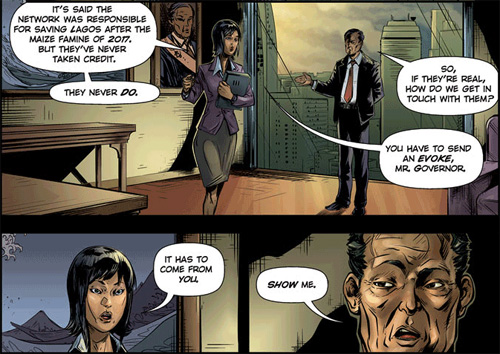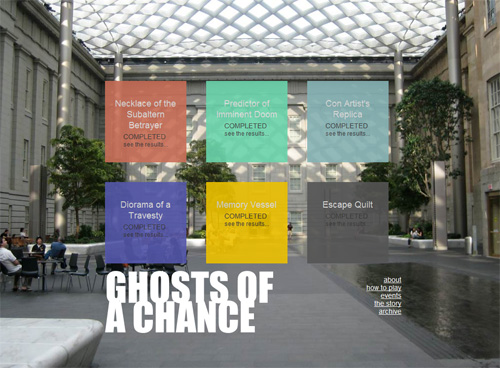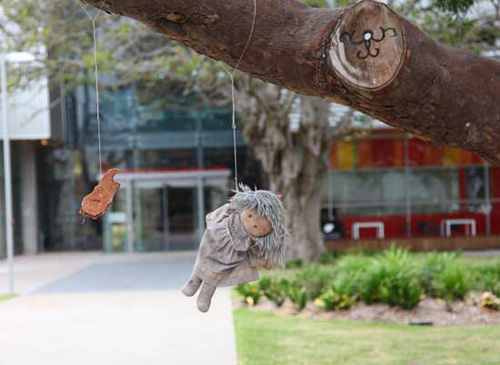This resource contains examples of alternate reality games (ARGs) created for museums, libraries, schools, and government agencies. Also included are links to related resources, designers, observers, and policy-makers. Please see my dissertation project, Reality Ends Here, for more up-to-date information about this topic.
Know of something that should be listed here? Please get in touch with me via the comments and I will update the resource.
Museums
Games
- Ghosts of a Chance (Smithsonian, 2008-2010) “We live in a world in which information and entertainment are customizable and immediately available. The Internet has become a larger part of everyday life, and so too have networked games, as people seek community, activity, a sense of achievement, and the chance to be part of something bigger . . . Museums can reach out to their audiences in more ways, using blogs, podcasts, video, and social media, but can they meaningfully engage visitors using games? In the fall of 2008, the Smithsonian American Art Museum hosted an Alternate Reality Game titled “Ghosts of a Chance.” We did this with three goals in mind: to broaden our audience, to do a bit of self-promotion, and, most importantly, to encourage discovery around our collections in a new, very interactive way. This paper will discuss the challenges that the museum faced, evaluate the successes and failures of each part of the game, and make recommendations for other museums interested in trying something similar.” (Archimuse)
- More on Ghosts of a Chance: Georgina Goodlander’s paper, Nina Simon’s blog writeup, Anika Gupta’s piece on Smithsonian.com and goSmithsonian, Washington Post coverage, and NPR’s coverage.
- PHEON (Multiple institutions, 2010) “For the past couple of months CityMystery has been building a new game, called PHEON. (A pheon is an ancient Greek arrowhead that has come to symbolize nimbleness of wit.) The purpose of our game is to celebrate (and reinforce) the American impulse to innovate. An economist friend of mine recently said that we have to “invent” our way out of our current mess. With PHEON I am promoting the idea that Americans understand innovation as a reoccurring utility of our democracy, one that matches our ability to adapt and succeed. PHEON’s subtext has to do with how ideas are passed along: how one person articulates a wish that another fulfills.” (“Sneak Preview of a New Museum Game“)
- More on PHEON: see Pass on the PHEON!.
- Many museums are also developing location-specific games and storytelling activities (like this or this) that don’t fit comfortably into the definition of an ARG. For some starting points for looking into these kinds of projects, see my locative media and ambient storytelling resources, and visit Nancy Proctor’s site, Museum Mobile.
Articles and discussions
- Reshaping the art museum June 2009 article from ArtNews: “Confronted with urgent demographic realities, art-museum directors are drawing on game theory, interactive technology, and a host of other new strategies to help people feel welcome, engaged, and emotionally fulfilled.”
- Smithsonian 2.0 “The two-day Smithsonian 2.0 gathering explores how to make SI collections, educational resources, and staff more accessible, engaging, and useful to younger generations (teenage through college students) who will largely experience them digitally. Over 30 creative people from the web and new media world will meet with 30 Smithsonian staff members to generate a vision of what a digital Smithsonian might be like in the years ahead.”
Libraries and Library Systems
Games
- Find Chesia (Carroll County MD Public Library, 2009) “Carroll County Public Library simply defined their ARG as a game played online and in the real world, where players solve puzzles, collect clues and objects, and ultimately find out about the mysterious Chesia. The library’s definition focused on the interactive story element and the promotion of technology literacy. Lynn Wheeler, Director of Carroll County Public Library, expressed pride in the project and the volunteers and staff who ‘have worked tirelessly to create delightful opportunities for teens to learn about and in turn use Web 2.0 technologies to create fun learning activities.'” (School Library Journal)
- Blood on the Stacks (Trinity University, 2006-2007) “Blood on the Stacks began in the spring of 2006, with a charge from Library Director Diane Graves to invent an orientation to follow in the footsteps of the hugely successful Harry Potter-themed orientations created by science librarian Barbara MacAlpine. Librarians Jeremy Donald, Clint Chamberlain and Jason Hardin created a mixed-media, digital/analog experience that treated the library as both a cyberspace and a bricks-and-mortar campus hotspot. Communication professor Aaron Delwiche supplied the idea of making the library orientation an ‘alternate reality game,’ where a fictional online narrative combines with real-world people, places, and events to create a game that blurs the boundary between the real and the imagined, the online environment and physical reality.” (lib.trinity.edu)
Universities, Colleges and K-12
Games
- Reality (University of Southern California, 2011-) Collaborative production game driven by digitally-connected collectible cards, designed to accelerate creative serendipity and peer discovery. More info: here. See also, Wired article and henryjenkins.org.
- AFTRS/LAMP induction and orientation ARGs (Australian Film Television and Radio School, 2005-2009) “Mini Alternate Reality Games (mARGs), collaborative play and quests as part of LAMP residentials or AFTRS inductions.” Includes games designed by Gary Hayes and Christy Dena.
- ARGOSI (Manchester Metropolitan University/University of Bolton, 2008-2009) “Alternate Reality Games for Orientation, Socialisation and Induction (ARGOSI) was a JISC-funded project that ran from April 2008 to March 2009. It designed and piloted an Alternate Reality Game (ARG) to support the student induction process. This small-scale pilot project was . . . aimed to provide an engaging and purposeful alternative to traditional methods of introducing students to university life.”
- WOW! A Song for Skatz (UK K-12, 2009) Nikki Pugh, lead artist for this project, describes this ARG-like school activity as: “Immersive – you’re in it, it takes over; Challenging – you will be outside your comfort zone. You will step up; you will learn; you will grow; Awesome – it will be beyond your expectations. It will give you things that could not have been planned; Inspiring – there will be spaces left for you to fill in in imagination technicolour; Pervasive – it will seep out of the classroom and reach beyond lesson times; Malleable – it will mean different things to different people; also, you will need to plan and contingency plan… and then adjust those plans on the fly in response to what is presented to you.” Check out Nikki’s fantastic project documentation here.
- Skeleton Chase (Indiana University, 2008) “In late May [of 2008], Indiana University announced that it received a $185,000 grant from the Robert Wood Johnson Foundation to explore how interactive digital games can be designed to improve players’ health. . . The [alternate reality game produced with this grant] was a collaboration between professors Anne Massey (Kelley School of Business), Jeanne Johnston (Kinesiology Department), and Lee Sheldon (Telecommunications Department).” (ARGNet)
Articles and Discussions
- Alternate reality games for developing student autonomy and peer learning Nicola Whitton’s case study of the ARGOSI project at Manchester Metropolitan University: “This paper discusses the educational potential of alternate reality games (ARGs), a relatively new game format that takes place both online and in the real world over a number of weeks, and combines narrative and puzzles to develop a collaborative community. In this paper, first the concept of ARGs are described, including their history and composition, and their potential pedagogic benefits are discussed in relation to constructivism, student autonomy and peer learning.” (lick2008.wikispaces.com)
- See also: Nicola Whitton’s ARGOSI PowerPoint presentation from the 2008 Let’s Change the Game Conference.
- MacArthur Digital Media and Learning Competition: ARG proposals Play without Borders and Earthrise are two recent DML competition proposals for school-based ARGs.
- Peer Puppeteers: Alternate Reality Gaming in Primary Schools “In this paper I will be reporting on a crosscurricular multi-media literacy project undertaken in a large South London Primary School over two years, which represents one element of my ongoing research into the potential of Alternate Reality Gaming in Primary Education.” (Angela Colvert)
Government, meta-institutional, and more
Not all educational or public-minded ARGs are necessarily tied down to a single institution or system. Here are a few notable games that have been produced outside of museums, libraries, and schools while still serving a larger learning or public service purpose:
Games
- ARGuing (European Commission Lifelong Learning Programme, 2010) “The ARGuing project helps teachers use the Internet (see Web 2.0 ) within language education. The project is funded by the European Union within the Comenius Lifelong Learning Programme. The project has developed and piloted a massive and very successful Alternate Reality Game (see Alternate Reality Games ) called the ‘Tower of Babel’ to ‘Engage’, ‘Motivate’ and ‘Excite’ students to learn languages using the new possibilities that the Internet age offers us (see more). ARGuing will build an educational methodology and teacher training guides and courses that can be used by teachers and teacher trainers to learn and understand how they can use the Internet, in a similar way to how their students are already using technology.”
- EVOKE (World Bank Institute, 2010) “When we evoke, we look for creative solutions. We use whatever resources we have. We get as many people involved as possible. We take risks. We come up with ideas that have never been tried before. An evoke is an urgent call to innovation. Evoking first started in Africa, but it can happen anywhere. And if you found this message, then it is your destiny to join us.”

- More on EVOKE: McGonigal describes the game on CNN
- Routes (Channel 4 Education/The Wellcome Trust, 2009) “Routes is an eight week game from Channel 4 Education in association with the Wellcome Trust that takes players into a world of genetics, evolution and the human genome.”
- World Without Oil (Corporation for Public Broadcasting, 2007) “WORLD WITHOUT OIL is a serious game for the public good. WWO invited people from all walks of life to contribute ‘collective imagination’ to confront a real-world issue: the risk our unbridled thirst for oil poses to our economy, climate and quality of life. It’s a milestone in the quest to use games as democratic, collaborative platforms for exploring possible futures and sparking future-changing action. WWO set the model for using a hot net-native storytelling method (‘alternate reality’) to meet civic and educational goals. Best of all, it was compellingly fun.”
Articles and Discussions
- Federal multi-agency Alternative Reality Game “The general idea of a multi-agency ARG would be to use game play as a way of engaging citizens in an exploration of democratic ideals. It would also be a way to discover new connections between Federal agencies, and new ways of connecting citizens to their government.” (Smithsonian 2.0)
Designers, observers, and policy-makers
- ARGLE Angela Colvert’s research into the potential of alternate reality gaming in education.
- Center for the Future of Museums “Musings on the future of museums and society from Elizabeth Merritt, founding director of the Center for the Future of Museums, an initiative of the american association of museums”
- Georgina Goodlander Manager of the Luce Foundation Center (visible storage) at the Smithsonian American Art Museum.
- Jane McGonigal Director of Games Research & Development at the Institute for the Future.
- John Maccabbee Game designer/producer/writer; involved in Ghosts of a Chance and PHEON.
- Ken Eklund author and game designer.
- MOERG “Alex Moseley is an Educational Designer at the University of Leicester. He is a learning and teaching practitioner, and conducts research into skills and subject teaching and support using paradigms from online games and social networks.”
- Museum Mobile Nancy Proctor‘s MuseumMobile “is a forum for conversations about mobile interpretation – media & technology – for museums and cultural sites.” MuseumMobile also has a public wiki, which is an outgrowth of the Tate Modern’s Handheld Conference Wiki.
- Nicola Whitton “I feel that the combination of gaming characteristics and lo-fi environment in ARGs are ideally suited to learning.”
- Nikki Pugh “I work in the grey areas between and across Art, Science and Technology, instigating enquiry-led processes that are often highly participatory in nature.”
- Nina Simon “[works] with museums to design exhibitions, programs, and online experiences that engage visitors as co-creators and community members, not just consumers.” Her design consultancy, Museum 2.0 is “focused on creating participatory, dynamic, audience-centered museum spaces.”
- NITLE “The National Institute for Technology in Liberal Education (NITLE) is a community-based, non-profit initiative that helps liberal arts colleges and universities explore and implement digital technologies.”
- Playtime Anti-Boredom Society Creators of SF0 and many other exciting projects; involved in production of Ghosts of a Chance.
See also: ARGology.org: ARGs in Education & Training, IGDA ARG SIG Whitepaper 2006, IGDA ARG SIG wiki: Educators and ARGs, Google keyword search [1] [2] [3], Twitter hashtag #mtogo



awesome resource jeff! thx.
Hi, thanks for this listing – really valuable!
I work on schools projects that draw a lot on ARG-like thinking, though I’m not sure I can out-right call them ARGs: role play and mission-based paths through immersive experiences, usually spanning a few consecutive days.
I’ve done a post-mortem on one of my projects that may be useful for others working (or considering working) in this way: http://npugh.co.uk/blog/how_to_wow_day_1/
Also bits and pieces get posted to my blog under this tag:
http://npugh.co.uk/tag/schools/. YMMV!
Hi Nikki,
Great documentation — looks like a lot of fun. I’ll add this to the resource!
Jeff
Just read this amazing story about Columbia College in Chicago and how they’re combining game design and behavioral science to create collaborative games: http://cms.colum.edu/demo/2010/02/game_on_2.php#more
Pingback: Going Mobile in Museums: Nancy Proctor « westmuse
Pingback: Trap doors and hatches all around: Jeff Hull on infusing variability and play into the workaday world | jeff watson
Pingback: Trap doors and hatches all around: Jeff Hull on infusing variability and play into the workaday world | jeff watson
You can also add GISKIN ANOMALY, a project I created for the Balboa Park Online Collaborative (a consortium of museums and cultural institutions in Balboa Park, San Diego). GISKIN is an immersive cellphone adventure, the history-culture tour “for people who don’t do audio tours.” More at the GISKIN website: http://giskin.org
and my guest blog about it at Museum 2.0: http://museumtwo.blogspot.com/2011/05/guest-post-lessons-learned-designing.html
@thacher I have a list of edu/museum ARGs here http://t.co/Dt6BPrpr …a little out of date but maybe helpful cc @jimbabb @mjandersen
thanx for this list of edu/museum ARG @remotedevice http://t.co/FVKOuG7y
Pingback: Down the Rabbit Hole: How To Turn Your Class into an Alternate Reality Game